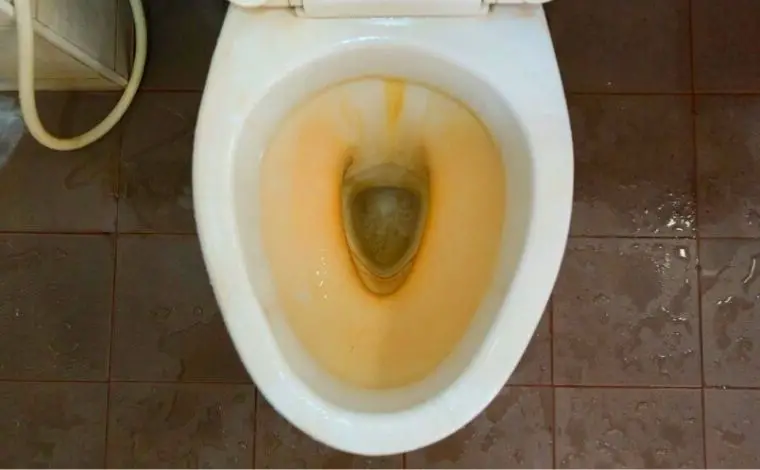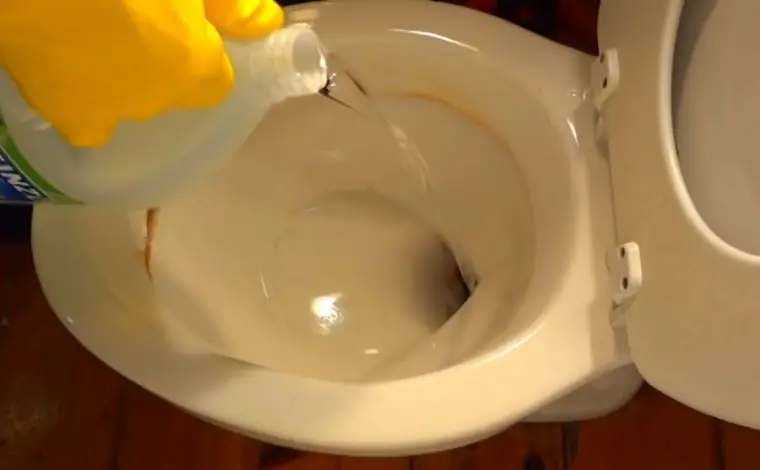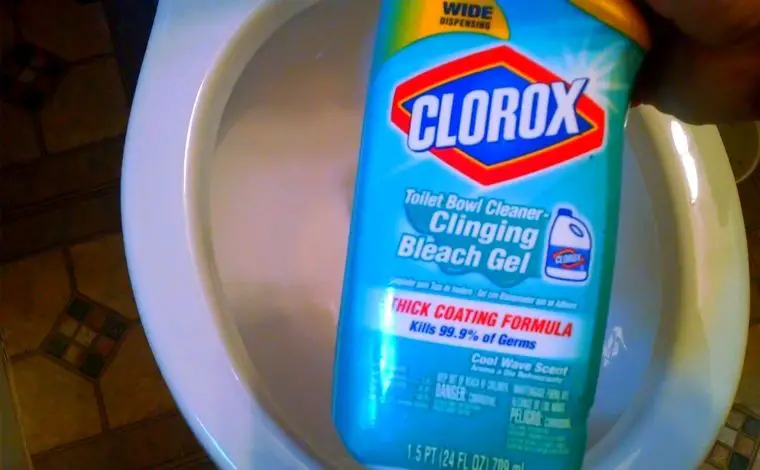When homeowners complain about bathroom cleanliness, one of the most common issues they mention is the ugly ring that forms around the waterline inside the toilet. This stain is popularly known as a toilet bowl ring. It may appear yellow, brown, black, orange, or even pink depending on the underlying cause, but in every case, it looks unhygienic and unpleasant.
So, what causes toilet bowl ring in the first place? To understand the problem, you need to know what’s actually happening inside the bowl.
A toilet bowl ring is the result of a combination of three major factors:
- Mineral Deposits: Hard water is often rich in calcium, magnesium, manganese, and iron. As water evaporates around the waterline, these minerals crystallize on the porcelain, leaving behind chalky or discolored stains.
- Microbial Growth: Bathrooms provide the perfect environment for bacteria, mold, and mildew. These organisms thrive in the constantly moist conditions inside the toilet bowl and attach themselves to the mineral buildup.
- Organic Matter: Waste particles, tannins from decayed matter, and other impurities in water supply can further darken or color the stains, making the rings even more noticeable.
Because the waterline never fully dries, the surface becomes a “sticky zone” where minerals and microbes continuously settle and grow. Over time, the stains become stubborn, resisting ordinary brushing or light cleaning.
In short, a toilet bowl ring is not just dirt—it’s a mix of mineral scale, microbial colonies, and organic residues. That’s why knowing what causes toilet bowl ring is essential before choosing the right cleaning or prevention method.
Different Types of Toilet Bowl Rings and Their Causes
| Toilet Ring Color | Possible Reason |
| What causes a black ring in the toilet bowl? | Calcium and magnesium |
| Pink color bowl rings: | Harmful Bacteria |
| Red color bowl toilet rings: | Acute Iron elements |
| Green color bowl rings: | Mold and fungus |
| Orange color bowl rings: | Magnesium and iron particles |
| Dark brown color bowl rings: | Acute hard water |
| Yellow color toilet bowl rings: | Tannins and poop marks |
Now that we understand the basics of a toilet bowl ring, let’s take a closer look at the different types of stains you might encounter. Not all rings are the same—each color tells a story about the underlying problem. Knowing the cause helps you pick the right solution instead of endlessly scrubbing.
So, what causes toilet bowl ring to appear in so many colors? It usually depends on the minerals present in the water, the bacteria growing in the bowl, and the overall bathroom conditions. Below are the most common types of toilet rings and their specific causes.
1. Yellow Toilet Bowl Rings
-
Cause: Yellow stains are often created by tannins—organic matter found in decayed vegetation and sometimes present in municipal water supplies. In many cases, poop residue also contributes to yellow discoloration.
-
Appearance: Can range from a faint light yellow to a dark golden-brown, similar to tea or ginger stains.
-
Significance: While not dangerous, they look very unhygienic and are among the most common types of toilet bowl rings.

2. Red or Orange Toilet Bowl Rings
-
Cause: High concentrations of iron or manganese in the water. Rust particles from old plumbing systems can also contribute.
-
Appearance: Rust-colored streaks or an orange ring around the waterline.
-
Significance: Persistent and stubborn. If not treated, they can point to corroding pipes or old metal plumbing.
3. Black or Dark Brown Toilet Bowl Rings
-
Cause: A result of hard water deposits rich in calcium and magnesium. Over time, these minerals bond strongly with the porcelain.
-
Appearance: Thick, dark, stubborn stains that are very difficult to scrub away with ordinary cleaners.
-
Significance: A strong indicator of hard water problems. Usually requires a water softener or heavy-duty cleaners.
4. Green or Blue-Green Toilet Bowl Rings
-
Cause: These are linked to mold, mildew, and sometimes corrosion from copper plumbing pipes. Electrolysis from mixed metal pipes may also cause greenish discoloration.
-
Appearance: Slimy green or bluish-green stains around the bowl.
-
Significance: Could be a sign of unbalanced pH in the water supply or mold growth in a humid bathroom.
5. Pink Toilet Bowl Rings
-
Cause: Caused by bacteria, particularly Serratia marcescens. This bacteria thrives in damp, poorly ventilated areas.
-
Appearance: Starts as a faint pink film, then darkens over time if ignored.
-
Significance: Harmless to health but looks very unsanitary. Requires regular disinfection.
Why These Color Differences Matter
Each ring color provides a clue to what causes toilet bowl ring in your home:
- Yellow → Tannins or waste stains.
- Red/Orange → High iron or rust.
- Black/Brown → Hard water mineral buildup.
- Green → Mold, mildew, or pipe corrosion.
- Pink → Bacterial growth.
By identifying the color, homeowners can narrow down the cause and select the right cleaning method. For example, while vinegar and baking soda may work for yellow tannin stains, iron-based red stains may need a rust remover or water filtration system.
Why Toilet Bowl Rings Keep Coming Back
Many homeowners often ask: “I just cleaned my toilet yesterday, so why is the ring back again today?” The frustration is real. To truly solve the problem, you need to know not only what causes toilet bowl ring in the first place but also why they return so quickly even after scrubbing.
1. Hard Water Minerals
One of the biggest culprits behind recurring toilet rings is hard water. Water that contains high levels of calcium and magnesium leaves behind chalky mineral deposits on the porcelain. Once these deposits settle, they create a rough surface. That roughness makes it easier for stains, bacteria, and organic matter to cling to the bowl, causing rings to reappear in no time.

Even if you scrub them away, fresh hard water flows in with every flush, depositing more minerals and restarting the cycle.
2. Iron and Manganese in Plumbing
If your water supply is rich in iron or manganese—or if your home has old metal pipes—you’ll notice rusty red or orange rings that keep coming back. This is because each flush brings in more iron particles, which oxidize and stick to the bowl. Without installing a water filtration or softening system, cleaning becomes a never-ending battle.
3. Microbial Growth (Mold, Mildew, and Bacteria)
Bathrooms are naturally humid spaces, making them perfect breeding grounds for microorganisms. The toilet bowl, constantly wet, provides an ideal home for bacteria such as Serratia marcescens (which creates pink stains) or mold that leads to greenish rings.
These microbes multiply quickly, so even if you disinfect one day, they can recolonize by the next. Poor bathroom ventilation only makes the problem worse.
4. Damage from Harsh Cleaning Products
It might sound ironic, but overusing aggressive chemicals like bleach or abrasive powders can actually make toilet bowl rings worse in the long run. These products can scratch or dull the porcelain surface, leaving microscopic grooves. Once damaged, the surface traps minerals, tannins, and bacteria much more easily, ensuring that the ring comes back faster.
5. Inconsistent Cleaning Habits
Finally, one of the simplest but most overlooked reasons why toilet bowl rings reappear is irregular cleaning. If toilets are left uncleaned for weeks, stains harden and mineral deposits get thicker. Once the surface is stained, it becomes much harder to restore its smooth finish. That’s why weekly cleaning is essential for long-term prevention.
The Core Truth
To summarize, the reason what causes toilet bowl ring to come back again and again is a combination of:
- Hard water minerals sticking to rough surfaces.
- Iron and manganese constantly entering with new water.
- Fast-growing bacteria and mold thriving in damp conditions.
- Overuse of harsh chemicals damaging the bowl surface.
- Skipping regular cleaning routines.
The key takeaway is that toilet bowl rings are not just a one-time cleaning issue—they’re a maintenance and water-quality problem. Unless you fix the root causes, they will always return.
Effective Methods to Remove Toilet Bowl Rings
Now that you know what causes toilet bowl ring and why it keeps coming back, the next step is learning how to get rid of it effectively. The good news is that you don’t always need expensive products or harsh chemicals. With the right approach, you can tackle both fresh stains and stubborn, long-standing rings.
Below are some of the most effective methods for removing toilet bowl rings.
1. Baking Soda and Vinegar (Natural Remedy)
This classic cleaning duo works wonders against mild to moderate toilet stains.
How to use:
-
Pour 1 cup of baking soda directly into the toilet bowl.
-
Add 2 cups of white vinegar.
-
The mixture will fizz and bubble—let it sit for 15–20 minutes.
-
Scrub gently with a toilet brush, focusing on the waterline.
-
Flush thoroughly.
👉 Best for yellow or light brown rings caused by tannins and mild mineral buildup.
2. Borax and Vinegar (Stronger Natural Solution)
Borax is stronger than baking soda and can cut through tougher stains.
How to use:
- Sprinkle a generous layer of borax powder around the toilet bowl, especially near the waterline.
- Pour 1–2 cups of vinegar on top.
- Let it soak for 20–30 minutes.
- Scrub the stains with a brush and flush.
👉 Effective against stubborn mineral deposits and light rust stains.
3. Bleach (Use With Caution)
Bleach has a bad reputation, but when used carefully, it can be an effective disinfectant.

How to use:
- Mix 1–2 tablespoons of pure bleach with 1 gallon of water.
- Pour into the bowl, making sure the solution reaches the waterline.
- Let it sit for 30 minutes to 1 hour.
- Scrub with a brush and flush thoroughly.
⚠️ Caution: Never mix bleach with vinegar, ammonia, or other cleaners—it can create toxic fumes.
👉 Works best on microbial stains such as pink or green rings caused by bacteria and mold.
4. Magic Erasers (Melamine Sponge)
For surface-level stains that resist brushing, a magic eraser is a gentle but effective tool.
How to use:
- Soak the sponge in water.
- Rub it directly against the toilet ring with light pressure.
- Flush to wash away loosened particles.
👉 Ideal for small, stubborn stains without damaging porcelain.
5. Pumice Stone (For Tough Deposits)
A pumice cleaning stone can remove hard water rings that refuse to budge.
How to use:
- Wet the pumice stone and keep it damp during use.
- Gently rub the ring in circular motions.
- Flush often to rinse debris away.
⚠️ Be careful—too much pressure may scratch the porcelain.
👉 Best for dark brown or black rings from calcium and magnesium buildup.
6. Commercial Toilet Cleaners
When home remedies don’t cut it, specialized cleaners can do the job. Options include:
- CLR (Calcium, Lime, Rust Remover): Targets rust and mineral deposits.
- Enzyme-based cleaners: Break down organic matter like tannins and bacteria.
- Drop-in tablets: Release cleaning agents with every flush to reduce buildup.
👉 Choose the cleaner based on the stain’s cause. For example, rust removers for red stains, or lime removers for hard water deposits.
7. Water Softening Solutions
If what causes toilet bowl ring in your home is hard water, the most long-term solution is installing a water softener. This prevents calcium, magnesium, and iron from binding to the porcelain in the first place.
Preventing Toilet Bowl Rings from Returning
Cleaning a stained toilet can feel satisfying in the moment, but the real frustration comes when the ring reappears just days later. Once you understand what causes toilet bowl ring, the next step is prevention. The key is to stop stains before they form, making your bathroom maintenance easier and your toilet looking fresh longer.
Here are the most effective strategies to keep toilet bowl rings from coming back.
1. Install a Water Softener
Hard water rich in calcium, magnesium, and iron is one of the biggest reasons stains return. Installing a water softener helps remove these minerals before they reach your toilet bowl. This reduces scale buildup and prevents dark brown, black, or rust-colored rings.
👉 If you live in an area known for hard water, this is the single most effective long-term solution.
2. Use a Toilet Bowl Tablet or Automatic Cleaner
Drop-in tablets or clip-on cleaners slowly release cleaning agents every time you flush. They keep bacteria under control and prevent mineral deposits from sticking.
⚠️ Choose chlorine-free versions if possible, since strong chemicals can damage the bowl surface over time.
3. Improve Bathroom Ventilation
Since mold and bacteria thrive in humidity, improving airflow can help. Installing an exhaust fan or simply keeping a window open allows moisture to escape. This makes it harder for pink or green stains caused by microbes to return.
4. Flush Regularly
One overlooked cause of toilet rings is stagnant water. If a toilet isn’t flushed often—such as in a guest bathroom—the still water encourages bacteria and mineral particles to settle. Flushing daily keeps the water fresh and prevents buildup at the waterline.
5. Adopt a Weekly Cleaning Routine
Consistency is more important than intensity. Instead of waiting until rings become stubborn, scrub your toilet lightly once a week with a mild cleaner. This stops small deposits from becoming hard, discolored stains.
👉 Remember: knowing what causes toilet bowl ring is useful, but prevention only works if you act regularly.
6. Avoid Harsh Abrasives
It’s tempting to scrub hard with steel wool or use aggressive chemicals, but these can scratch porcelain. Once scratched, the surface becomes rough, and stains will cling faster. Always use gentle brushes or pumice stones carefully.
7. Treat the Root Cause of Your Stains
- Yellow stains? Filter tannins from your water supply.
- Red or orange stains? Use a rust filter or replace corroded pipes.
- Black stains? Install a water softener to control calcium and magnesium.
- Pink stains? Keep bacteria under control with disinfectants and better ventilation.
By targeting the specific cause, you make it much harder for stains to come back.
The Prevention Mindset
The reality is that what causes toilet bowl ring cannot be completely avoided—water always contains some minerals and microorganisms. However, with the right preventive measures, you can greatly reduce how often stains appear and how difficult they are to remove.
A little weekly effort and some smart long-term solutions will keep your bathroom fresh, clean, and hassle-free.
Final Thoughts on What Causes Toilet Bowl Ring
By now, it should be clear that toilet stains are not random accidents. They are the result of a complex interaction between water quality, bathroom conditions, and cleaning habits. So, what causes toilet bowl ring? The short answer is:
- Hard water minerals such as calcium, magnesium, and iron.
- Organic matter and tannins from waste or water supplies.
- Microbial growth including mold, mildew, and bacteria.
- Damaged porcelain surfaces from harsh chemicals or abrasive tools.
- Inconsistent cleaning routines that allow stains to harden over time.
Understanding the cause is the first step. Once you know why the ring appears, you can take targeted action to clean it effectively and prevent it from coming back.
Cleaning vs. Prevention
Natural remedies like baking soda and vinegar, borax, or bleach can remove existing stains, while pumice stones and commercial cleaners help with more stubborn deposits. However, cleaning alone isn’t enough. If you want long-term results, you must address the source—whether it’s installing a water softener, improving ventilation, or sticking to a weekly cleaning schedule.
Why It Matters
Some people dismiss toilet bowl rings as just a cosmetic nuisance, but they can signal deeper issues: corroded plumbing, poor water quality, or hidden bacterial growth. Left untreated, they make your bathroom look unsanitary and harder to maintain.
By tackling what causes toilet bowl ring directly, you’re not just cleaning a stain—you’re improving your home’s hygiene, protecting plumbing fixtures, and saving time and effort in the long run.
Final Words
Toilets are among the most frequently used fixtures in any home, and keeping them clean should not feel like a never-ending battle. With the right knowledge, a proactive cleaning routine, and preventive strategies, you can finally put an end to recurring toilet rings.
So next time someone asks, “What causes toilet bowl ring, and how do I get rid of it?”—you’ll know the complete answer: identify the cause, use the right cleaning method, and prevent it from returning. Your bathroom will stay fresher, cleaner, and far more inviting.
Hi, this is Robert Crossan, the owner of this website, has 17 years of experience in the installation, maintenance, and repair of toilets and plumbing systems. After completing the Level 2 Basic Plumbing course in 2005, I started working in both domestic and commercial buildings as a professional plumber. So I can figure out the core difference between different toilet models and brands. It also helped me monitor their work performance and setbacks.